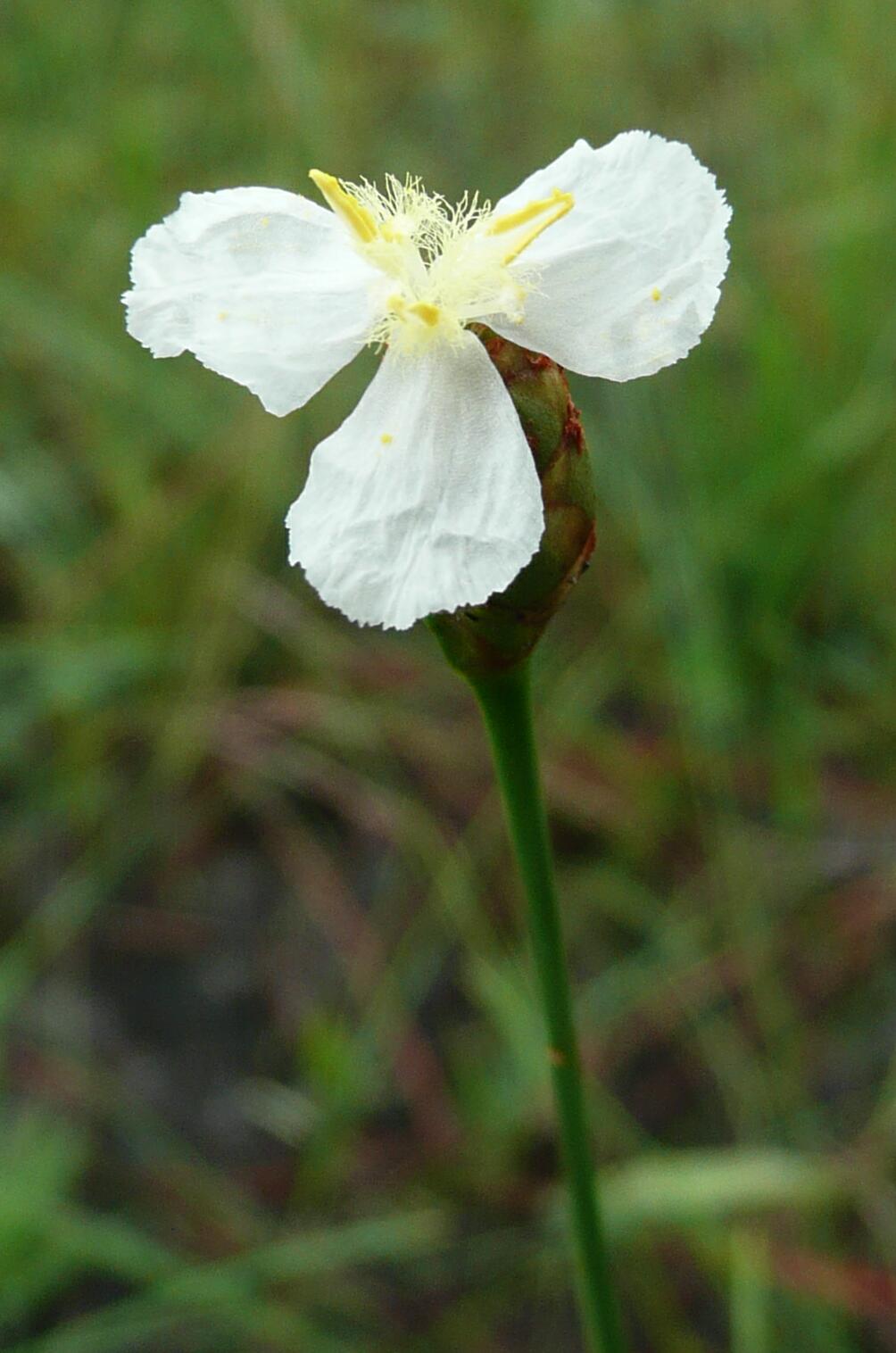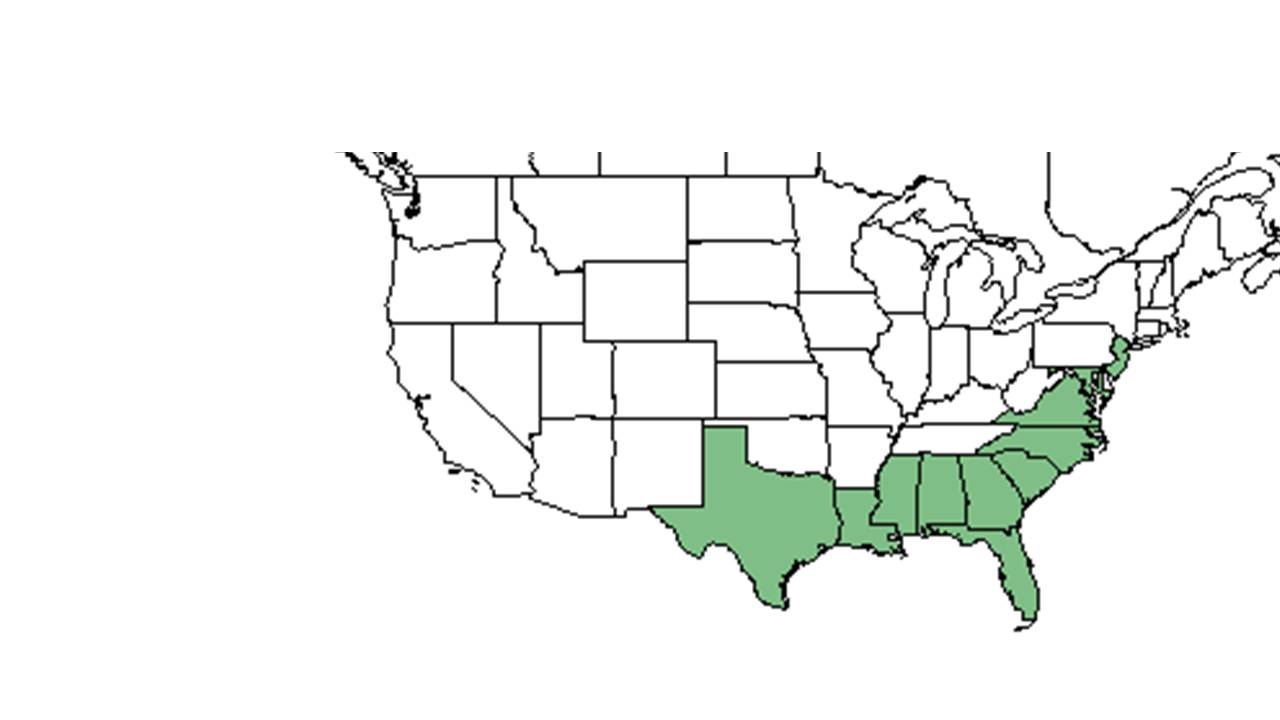Xyris caroliniana
| Xyris caroliniana | |
|---|---|

| |
| Xyris caroliniana, the Peninsular Florida white-flowered form | |
| Scientific classification | |
| Kingdom: | Plantae |
| Division: | Magnoliophyta – Flowering plants |
| Class: | Liliopsida – Monocotyledons |
| Order: | Commelinales |
| Family: | Xyridaceae |
| Genus: | Xyris |
| Species: | X. caroliniana |
| Binomial name | |
| Xyris caroliniana Walter | |

| |
| Natural range of Xyris caroliniana from USDA NRCS Plants Database. | |
Common name: Carolina yelloweyed grass
Contents
Taxonomic notes
Description
Solitary or in small tufts, the bases deeply set in the substrate, perennating by means of pale, elongated, fleshy lateral buds. Outer leaves scaly, castaneous; longer leaves linear, 2-5 (-7) dm long, 2-5 mm broad, twisted and flexuous, mostly smooth, minutely tuberculate along the margins, base abruptly dilated, dark brown, shiny, long-persistent as scales. Sheath of the scape shorter than the leaves, tight below, loose toward the oblique orifice which is tipped by a very short blade. Scapes linear, 5-10 dm long, twisted, flexuous, smooth, terete and minutely ridged below, the ridges minutely tuberculate, becoming oval in cross-section and smooth to 1-ridged above. Spikes 1-3 cm long, elliptic to narrowly lanceolate in outline, blunt to acute, of few to many closely imbricate bracts. Fertile bracts 0.5-1.3 cm long, oblong to obovate, entire or emarginate, becoming erose, the center ovate area gray-green, the wide margin light tan or brown. Lateral sepals linear, slightly to conspicuously exserted, tan to reddish brown with a broad keel which is entire below but fimbriate at its exserted apex. Petal blades obovate, 8-9 mm long, yellow in n. Fla., becoming more typically white in peninsular Fla., in most populations opening in the afternoon. Seeds fusiform, narrow, 0.8-1 mm long, translucent, with about 20 pale, stripelike longitudinal lines, the vertical lines apparent.
Additoinal description information of Xyris caroliniana is provided in The Flora of North America.
Distribution
Moist sands of pine flatwoods or savannas, well-drained sands or moist depressions of mesic to scrubby flatwoods, sandhills, and scrub. Summer-Fall. Common throughout Florida. Coastal Plain. New Jersey; southeast Virginia, south to Florida, west to southeast Texas.
Ecology
Habitat
In the Coastal Plain in Florida and Georgia, X. caroliniana has been found in mesic sandy meadows; seepage slopes with Rhynchospora; sandy loam of burned wiregrass-longleaf pinewoods; sandy peat of pine-palmetto flatwoods; sand of open slash pine woodland bordering Hypericum marshes; oak scrub at margin of pine flatwoods; wiregrass-palmetto-slash pine plantation; sandy peat of flatwoods bog; upper edge of grass-sedge bog; wet pine flatwoods; mixed hardwood/cabbage palm hammocks; sandy peat of hillside bogs; mixed pine-oak woodland; dry boggy area near small stand of cypress; sandy dune hallow; sandy loam at edge of Ilex myrtifolia depression swamp; turkey oak/longleaf pine barren; and in sand around ephemeral ponds (FSU Herbarium; Glitzenstein et al. 2003). In disturbed habitats has been found in roadside ditches; semi-disturbed remnant of longleaf pine-saw palmetto flatwoods; borrow pit bog; and in sandy peat of drained and bulldozed flatwoods bog.
Substrate types include sandy loam, sand, sandy peat, and fine sand (FSU Herbarium). Associated species include Rhynchospora, Hypericum, Fuirena scirpoidea, Fimbristylis caroliniana, Juncus scirpoides, Rhexia cubensis, Seymeria, Aristida stricta, Conradina, Ilex, Lyonia, Xyris elliottii, Ilex myrtifolia, Serenoa repens, Mitreola petiolata, Xyris flexuosa, Sabatia brevifolia, Kalmia hirsuta, Balduina uniflora, Polygala lutea, Sorghastrum secundum, Quercus pumila, Liatris graminifolia, and Helianthus heterophyllus (FSU Herbarium).
Phenology
It has been recorded flowering February, June through October and fruiting June through October (FSU Herbarium).
Seed dispersal
Seed bank and germination
Fire ecology
Pollination
Use by animals
Diseases and parasites
Conservation and Management
Cultivation and restoration
Photo Gallery
References and notes
Florida State University Robert K. Godfrey Herbarium database. URL: http://herbarium.bio.fsu.edu. Last accessed: Collectors: States and Counties: Compiled by Tall Timbers Research Station and Land Conservancy.
Glitzenstein, J. S., D. R. Streng, et al. (2003). "Fire frequency effects on longleaf pine (Pinus palustris, P.Miller) vegetation in South Carolina and northeast Florida, USA." Natural Areas Journal 23: 22-37.